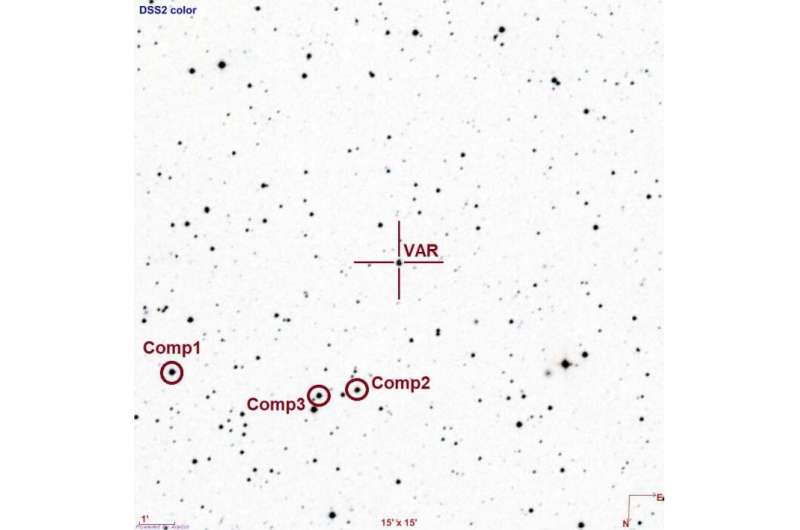January 9, 2023 report
This article has been reviewed according to Science X's editorial process and policies. Editors have highlighted the following attributes while ensuring the content's credibility:
fact-checked
preprint
trusted source
proofread
NSVS 2983201 is a contact binary system, observations find

Polish astronomers have performed photometric observations of a short-period variable star known as NSVS 2983201. They have found that the object is a contact binary system with a mass ratio of about 0.36. The finding was reported in a paper published December 28 on the arXiv pre-print repository.
Detecting and studying variable stars could offer important clues into aspects of stellar structure and evolution. Investigation of variables could be also helpful for a better understanding of the distance scale of the universe.
NSVS 2983201 (also known as KR00245) was initially identified as a variable with a relatively short orbital period of around 0.286 days, experiencing total eclipses. Follow-up observations of NSVS 2983201 have suggested that it may be a contact binary; however, due to very poor light curve coverage and the fact that no numerical modeling analysis of this object was performed, it could not be confirmed.
Now, a team of astronomers led by Bartłomiej Dębski of the Jagiellonian University's Astronomical Observatory in Kraków, Poland, provided observational evidence confirming the contact binary hypothesis. Their finding is based on photometric data from the Apogee Alta U42 camera on the Astronomical Observatory's Cassegrain telescope, collected in October 2022.
"We took 190 photometric frames in each filter: B, V, R and I. The exposure times were: 40 s, 30 s, 20 s, and 20 s, respectively. The calibration frames were collected on the same day (the on-sky Flatframes in each filter in the evening, while Bias- and Darkframes directly after the observations)," the researchers explained.
The team applied two methods in order to obtain fundamental parameters of NSVS 2983201. One of them points to a distance to this system of about 4,250 light years, while the other one indicates 4,560 light years. Based on the estimated distance, the absolute magnitude of NSVS 2983201 was found to be 4.71 and 4.56 mag, respectively.
These results, together with the system's mass ratio of approximately 0.3585, allowed the astronomers to calculate the orbital separation and masses of the two components of NSVS 2983201. Depending on the distance and absolute magnitude, the orbital separation was found to be 2.04 or 2.19 solar radii, which confirmed that it is a contact binary. If the orbital separation is smaller, then the masses of the primary and secondary stars were estimated to be 1.03 and 0.37 solar masses, respectively. In the second scenario, the primary star has a mass of about 1.27 solar masses, while its companion has nearly 0.46 solar masses.
The researchers added that the light curve that was obtained for NSVS 2983201 is burdened with the so-called O'Connell effect—there is a difference between the height of the brightness maxima. This enabled an identification of a large circumpolar starspot assumed to be of magnetic origin, hence visible in the visual wavelengths as a subluminuous region on the stellar surface. The authors of the paper assume that this spot belongs to the primary star as it would have a thicker convective envelope.
More information: B. Debski et al, A study of a contact binary system NSVS 2983201, arXiv (2022). DOI: 10.48550/arxiv.2212.14085
Journal information: arXiv
© 2023 Science X Network





















